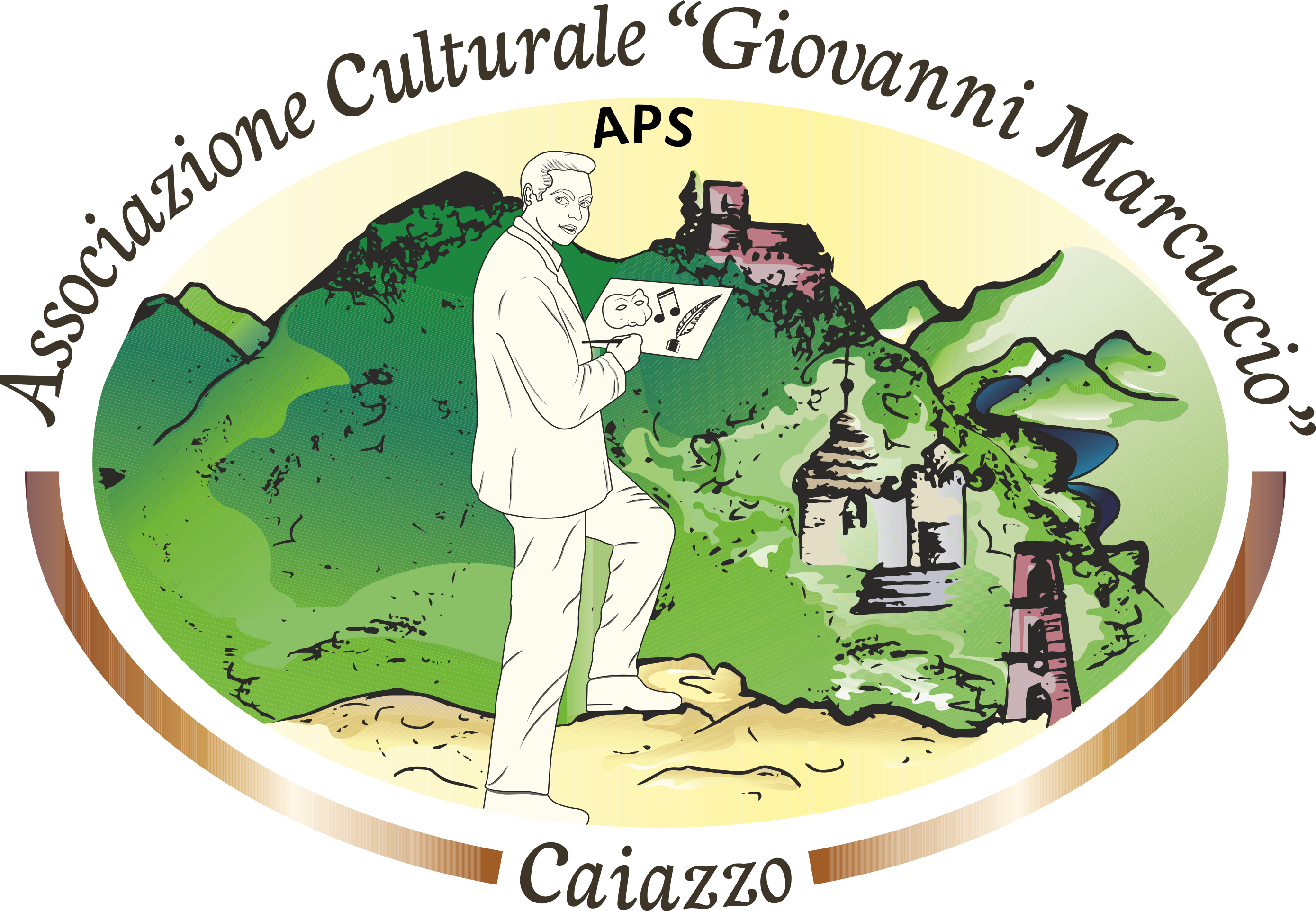The interiors of the Co-Cathedral
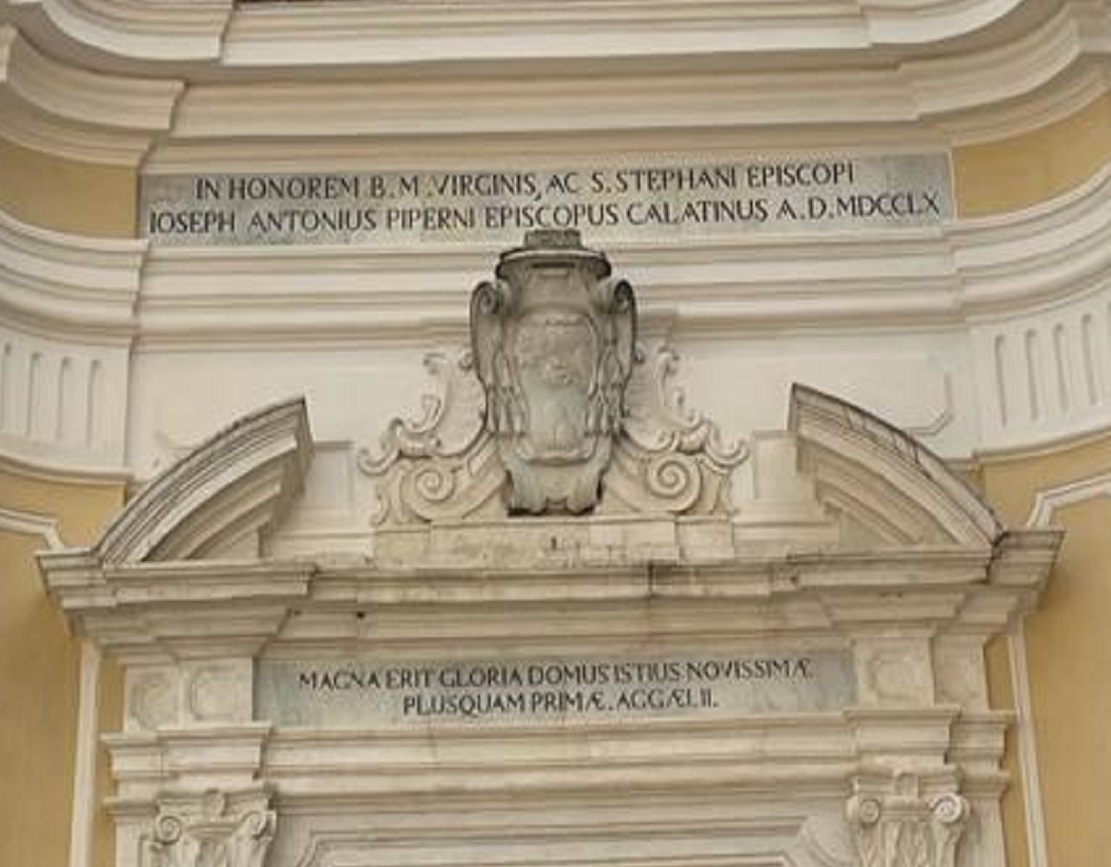
The inscription on the facade reads:
IN HONOREM B. M. VIRGINIS, AC S. STEPHANI EPISCOPI
JOSEPH ANTONIUS PIPERNI EPISCOPUS CALATINUS A.D. MDCCLX
“IN HONOR OF THE BLESSED VIRGIN MARY AND SAINT STEFANO VESCOVO
GIUSEPPE ANTONIO PIPERNI CAIATINO BISHOP YEAR DOMINI 1760”
The coat of arms of the bishop Piperni is shown under the inscription is composed on the upper left there is a sun, on the right an eagle’s paw holding a sphere and below three mountains.
The entrance to the structure consists of a portal that leads to the left aisle while the main entrance is the central portal above which we find another inscription that reads:
MAGNA ERIT GLORIA DOMUS ISTIUS NOVISSIMAE PLUS QUAM PRIMAE
GREATER WILL BE THE GLORY OF THIS LAST HOUSE THAN OF THE FIRST
The Co-Cathedral, dedicated to S. Maria Assunta, was elevated to the “Santo Stefano Menecillo” Sanctuary in June 2012, the following On June 13, 2013 the church was elevated to a minor Basilica.
In recent years, the structure has undergone restructuring work again and reopened on February 27, 2021. The restoration and conservation interventions on the outside have been carried out and on the surface of the facade (on the jutting cornices and on the stuccoes).
The façade was repainted in Neapolitan yellow in the parts not in relief this choice to highlight some elements such as the pilasters, friezes and reliefs that have been painted white.
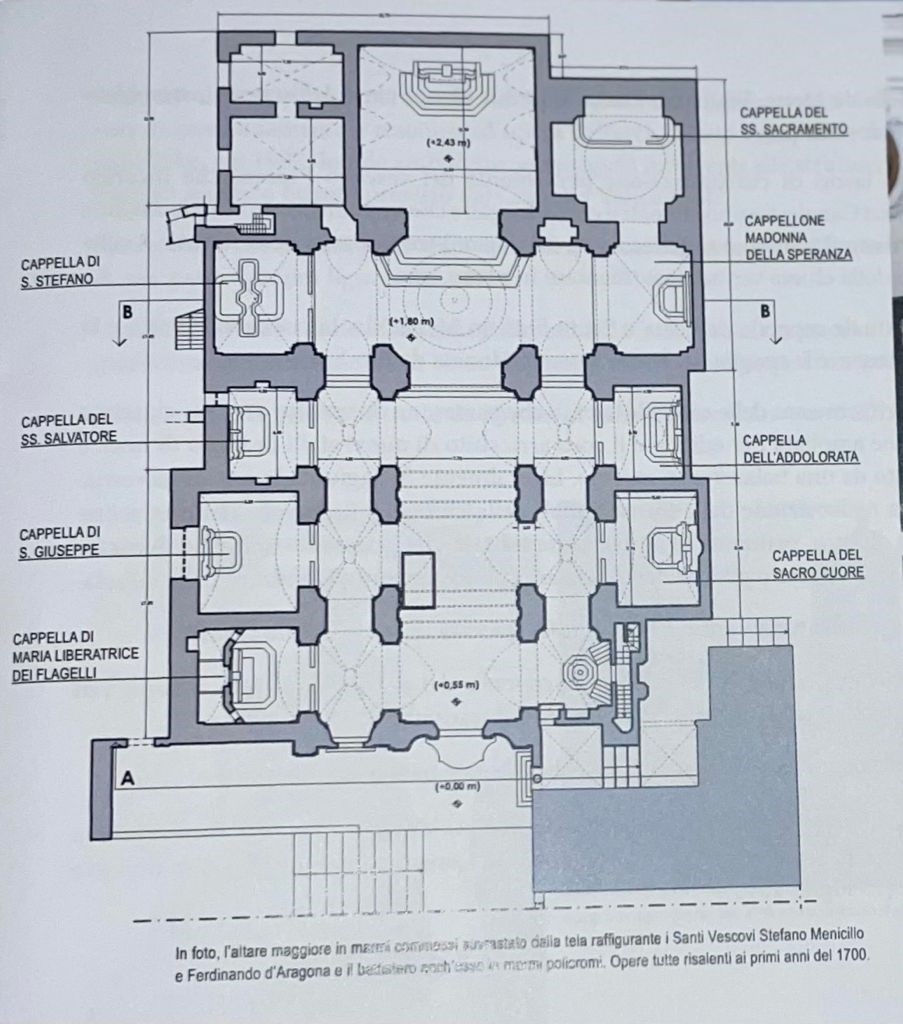
Map of the Concattredale
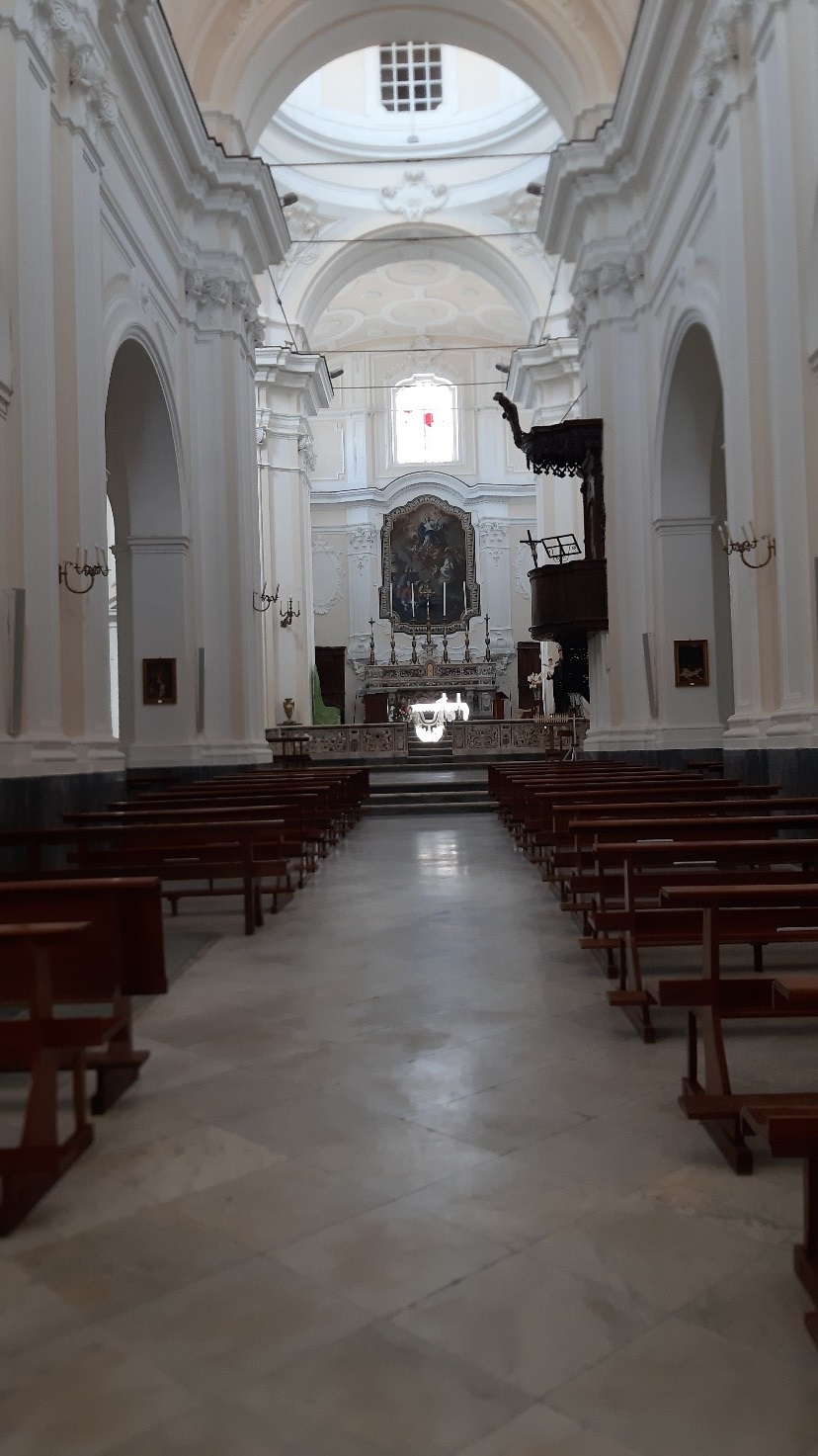
Interior of the Cathedral
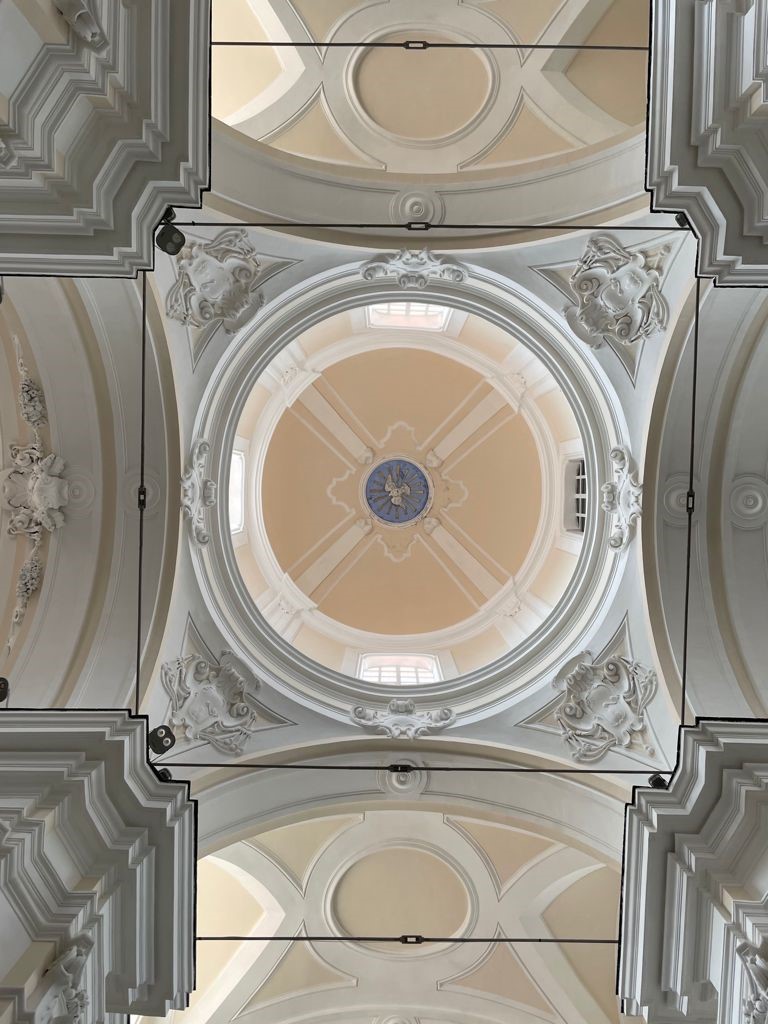
Dome
INTERIOR OF THE CATHEDRAL
The church has a Latin cross plan divided into three naves by pillars, at the intersection between the transept and the central nave there is the bowl-shaped dome covered with tiles and ending with a lantern covered with majolica.
The interior is decorated a putty.
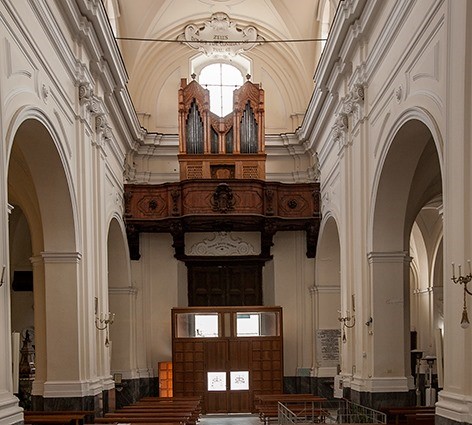

Pipe organ

Dettaglio Organo a Canne
Pipe organ
Above the entrance we find the wonderful pipe organ built in 1851 by the artists Domenico Castellucci and Pietro Petillo of Naples, subsequently dismantled to carry out the post-earthquake restoration of the 1980s, it was restored by the Fabrica Artigiana Organi Michelotto of Albignasego of Padua.
The organ is composed of two chromatic keyboards of 61 notes, a short straight pedalboard of 20 notes. Restored in 2012.
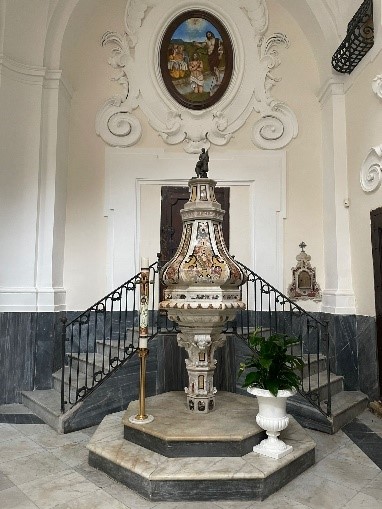
Baptistery
Baptistery
In front of the chapel of S. Maria dei Flagelli there is a wonderful baptistery in which the baptismal water is preserved. It has an octagonal shape (to symbolize the eighth day, like that of the Resurrection and the number eight as a symbol of infinity, alluding to the rebirth of the baptized). Behind the structure there is a door that represents the passage from sinful to eternal life.
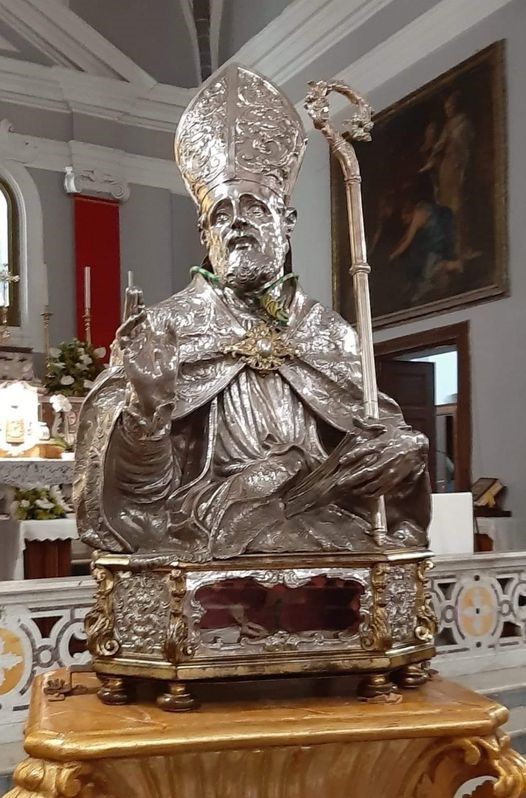
Santo Stefano Menicillo
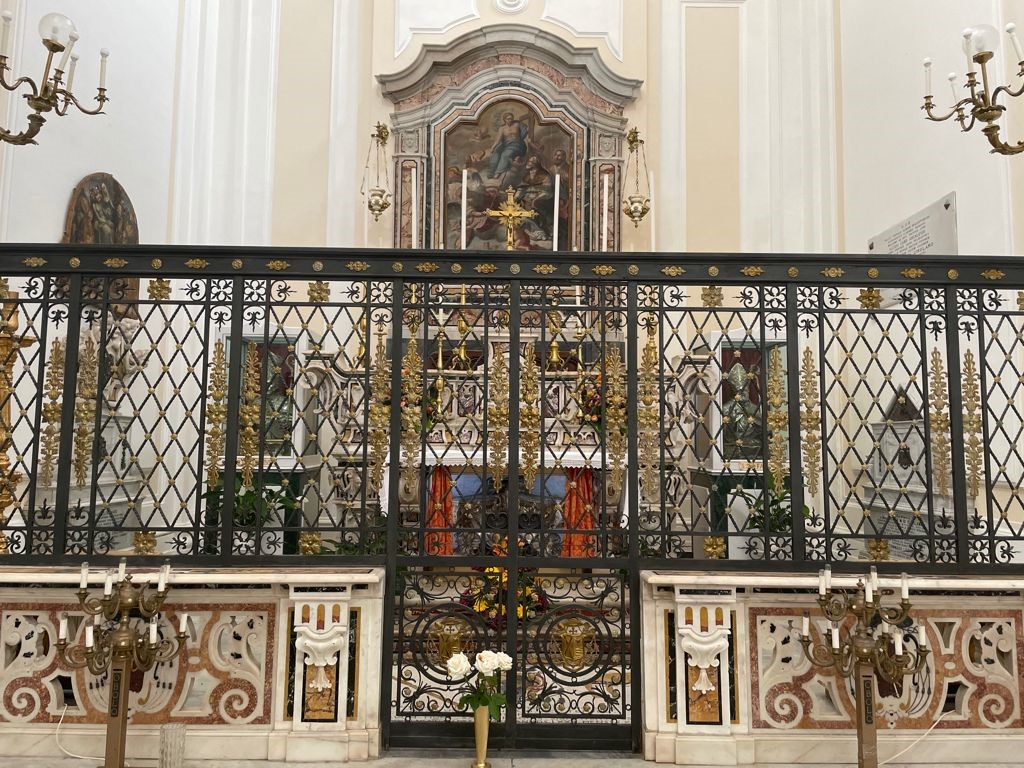
Chapel of Santo Stefano and San Ferdinando
Santo Stefano Menicillo
Santo Stefano Menicillo or Minicillo. Patron of the city of Caiazzo, born in 935 in Macerata Campania, trained at the Abbey of San Salvatore di Capua, he was bishop of Caiazzo from 979 to 1023. He died on 29 October 1023 after 44 years of episcopate and was declared a saint in October 1195.
According to tradition in Caiazzo, he used to pray near an olive tree located along the road that leads to the municipal cemetery. It is still present today & nbsp; a commemorative plaque on the occasion of the millennial of the saint’s consecration.
In May 28, 1512 the body of Saint Stephen was found uncorrupted by the event and welcomed by the people of Caiatino with jubilation. The body was placed in a chapel prepared with precious marbles near the altar. & Nbsp; After various times and a series of movements in 1936 the relics were placed in the chapel dedicated to him in a gilded bronze urn under the altar, placed by S. Piperni.
Among the most famous miracles we remember “The miracle of the column” which took place on Easter day 982 while the Holy Bishop, whose fame went beyond the confines of the diocese, was administering communion to a large crowd. He is near the balustrade when a column should fall to fall on the mass of the faithful without causing anyone to stop by the protective hand of the Saint.
Apart from the miracles he worked in life, Saint Stephen performed wonders even after his death, the year after his death he appeared to a pious woman at night ordering her to visit a priest suffering from a very strong fever and to explain to him that if had he gone to his tomb with true repentance you would have been healed. During the journey the same woman fell and praying to the Saint was healed. Later he managed to take the message to the sick priest who recovered.
Another great miracle was the liberation of a woman in the grip of diabolical possession, she was taken to the tomb of Santo Stefano and after the many prayers of the faithful the devil left exclaiming: “not you, not you, but Stephen has chased me away”.
Curiosity: in the co-cathedral, among the various relics, the blood of St. Pantaleone is also preserved.
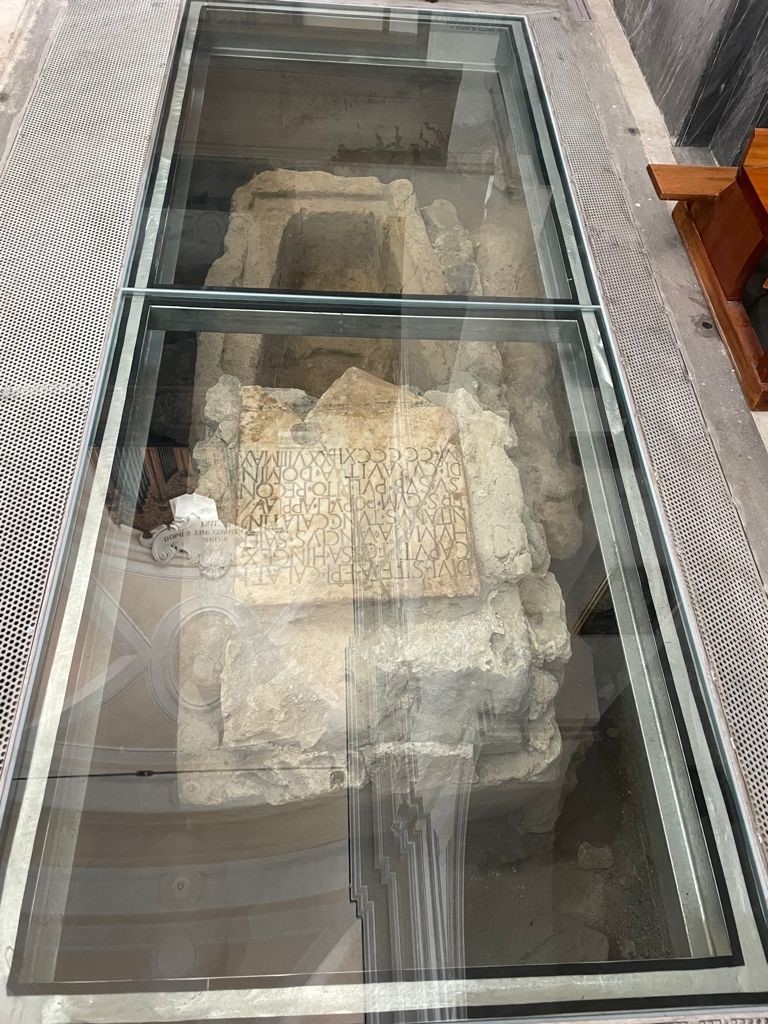
Sepulcher of Santo Stefano
In the cathedral, at the entrance, along the central nave on the left side we find the old tuff sepulcher where Bishop Menicillo was initially buried, recently covered by a glass that allows it to be seen safely. Every year on October 29, the date of his death, the Caiatini solemnly celebrate the patron saint.
THE CHAPELS
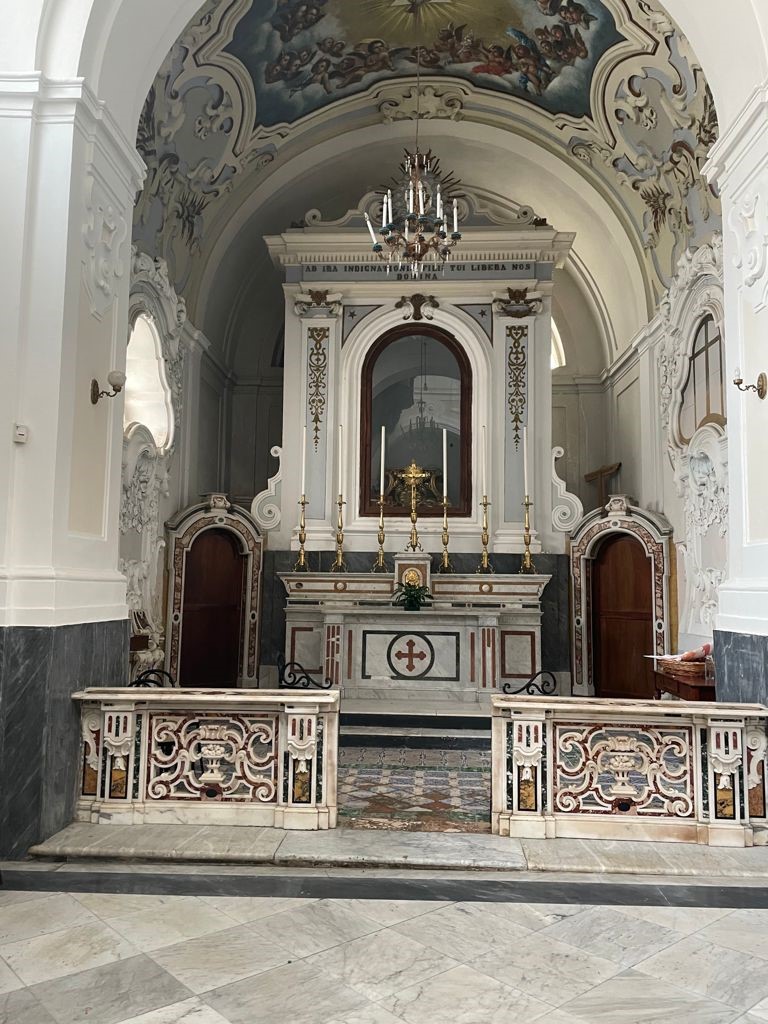
Chapel of Santa Maria dei Flagelli
Chapel of Santa Maria dei Flagelli
The first chapel on the left is currently dedicated to S. Maria dei Flagelli, but originally there was the Blessed Sacrament, in fact symbols such as the vine and wheat are still visible today.
Under the vault we can admire the dove symbol of the Holy Spirit with the Triangle representing the Holy Trinity.
The statue placed on the altar depicts Mary as a nineteenth-century woman with lightning and lightning bolts in one hand and baby Jesus in the other.
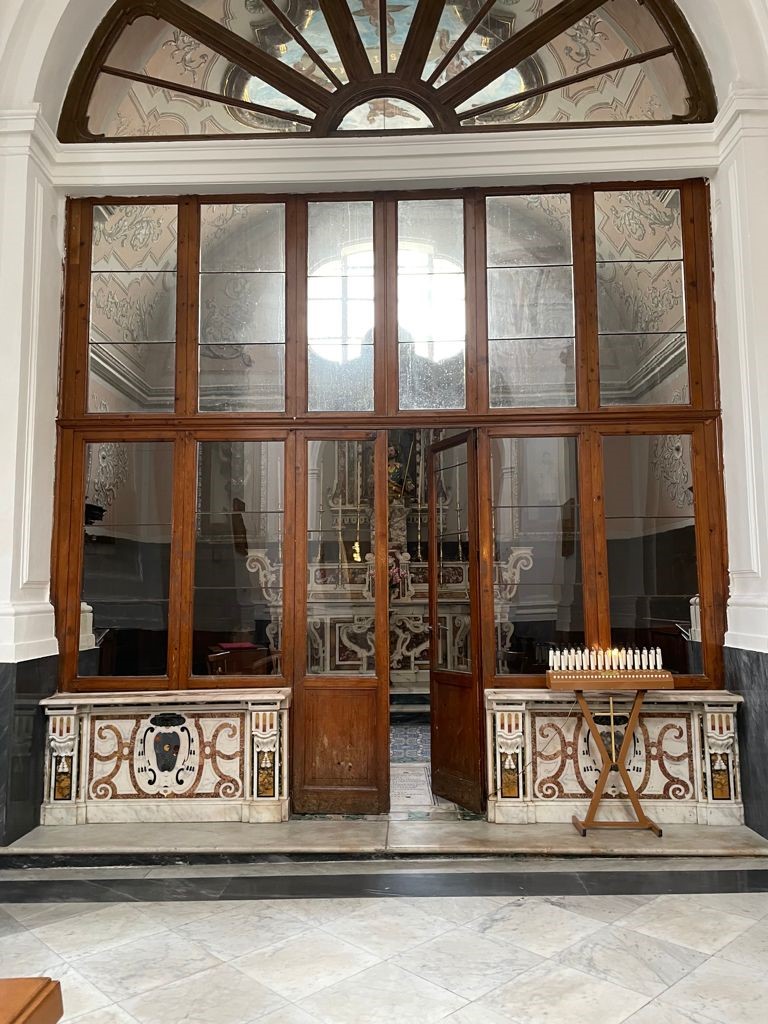
Chapel of
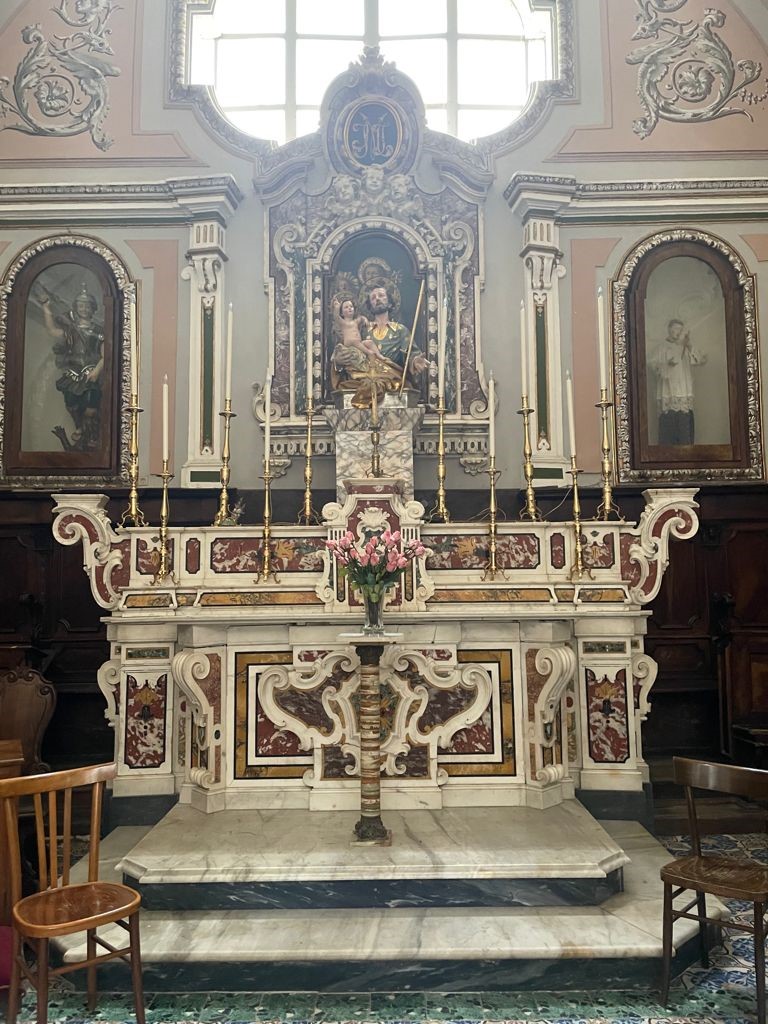
Interior Chapel of S. Giuseppe
Chapel of S. Giuseppe
The second chapel on the left is dedicated to S. Giuseppe, preserves the ancient majolica floor and wooden stalls.
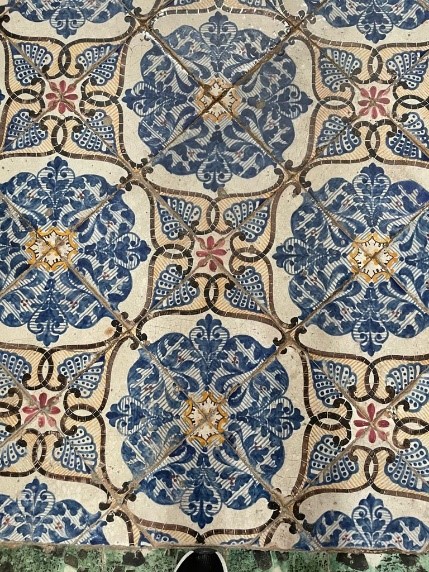
Detail of the pavement
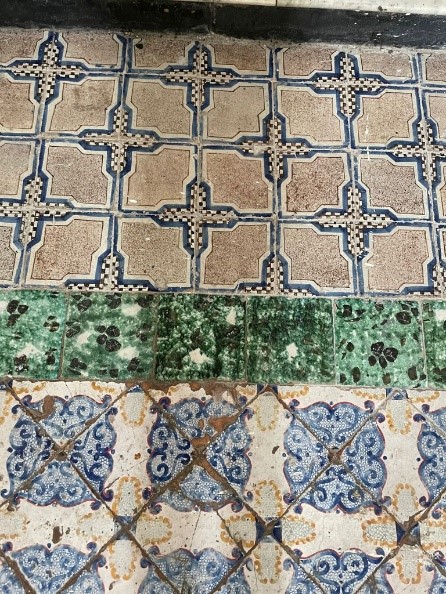
Detail of the pavement
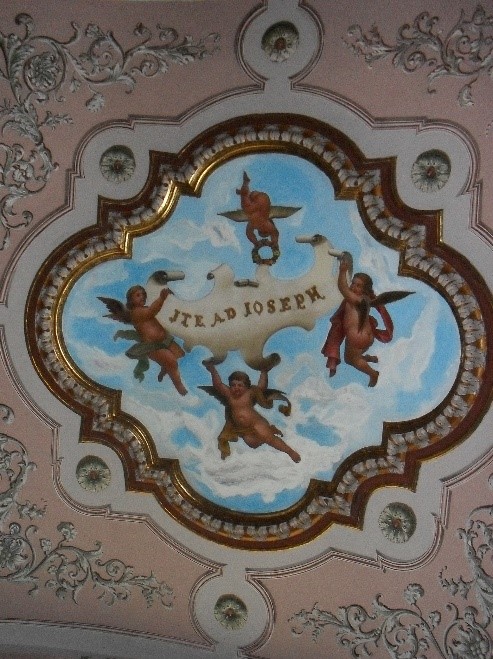
Co-cathedral ceiling
The ceiling is decorated with four cherubs in a blue sky that hold the inscription ITE AD JOSEPH (go to Joseph) that is an invitation to pray to the saint to ask him for intercession.
On the left of the chapel we find the painting The Marriage of the Virgin , in the center of which contrary to tradition there is not Mary but Joseph with the Holy Spirit, in his hand the stick that according to the episodes of the apocryphal gospels only flourished when it was our Joseph who touched him to symbolize that he was the chosen spouse for Mary.
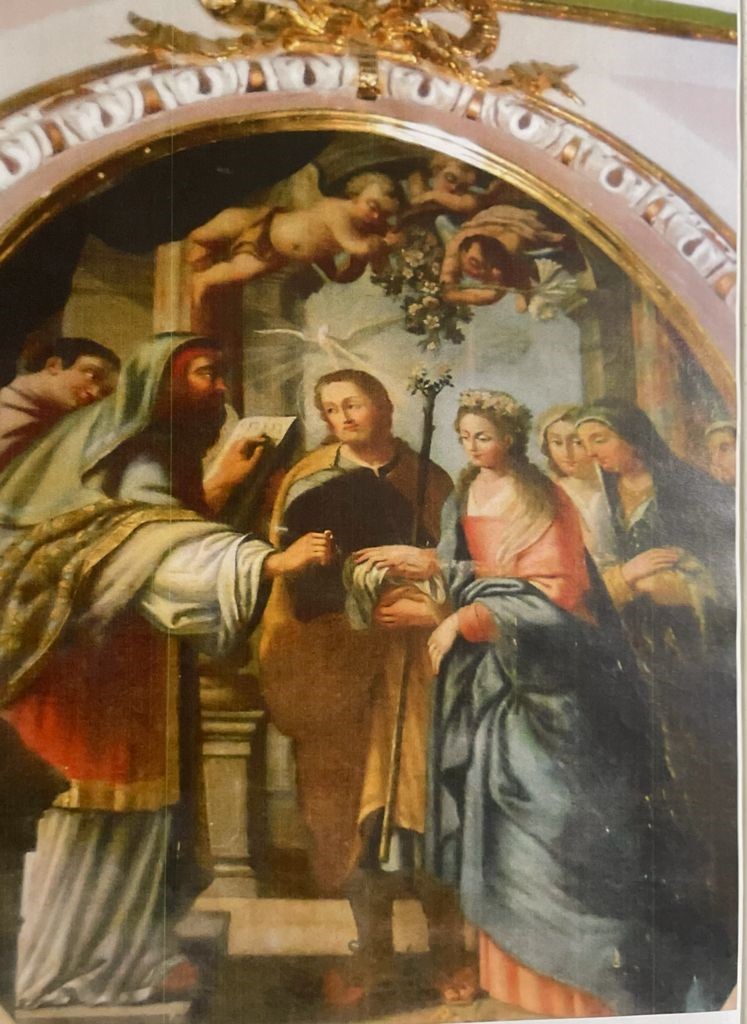
Painting Death of San Giuseppe with San Michael
To the right of the chapel is placed the painting Death of St. Joseph with St. Michael armed with a sword and Gabriel with a lily, two angels carrying symbols to the saint, namely the stick, tied flowers and instruments as a carpenter.
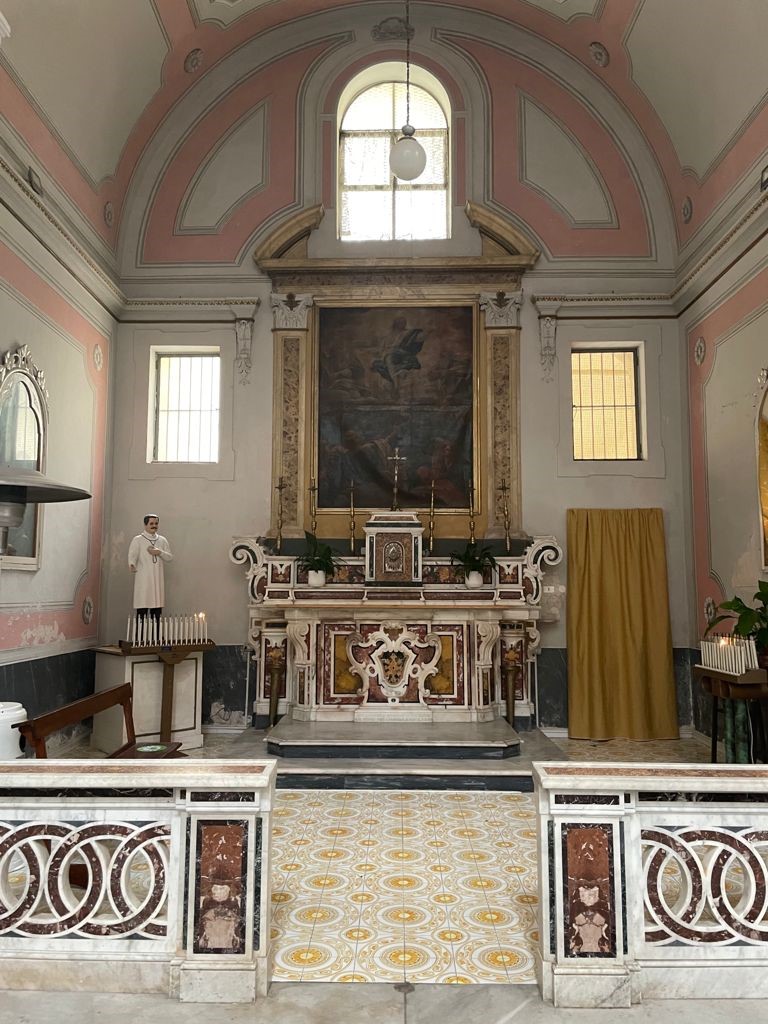
Chapel of the Most Holy Savior
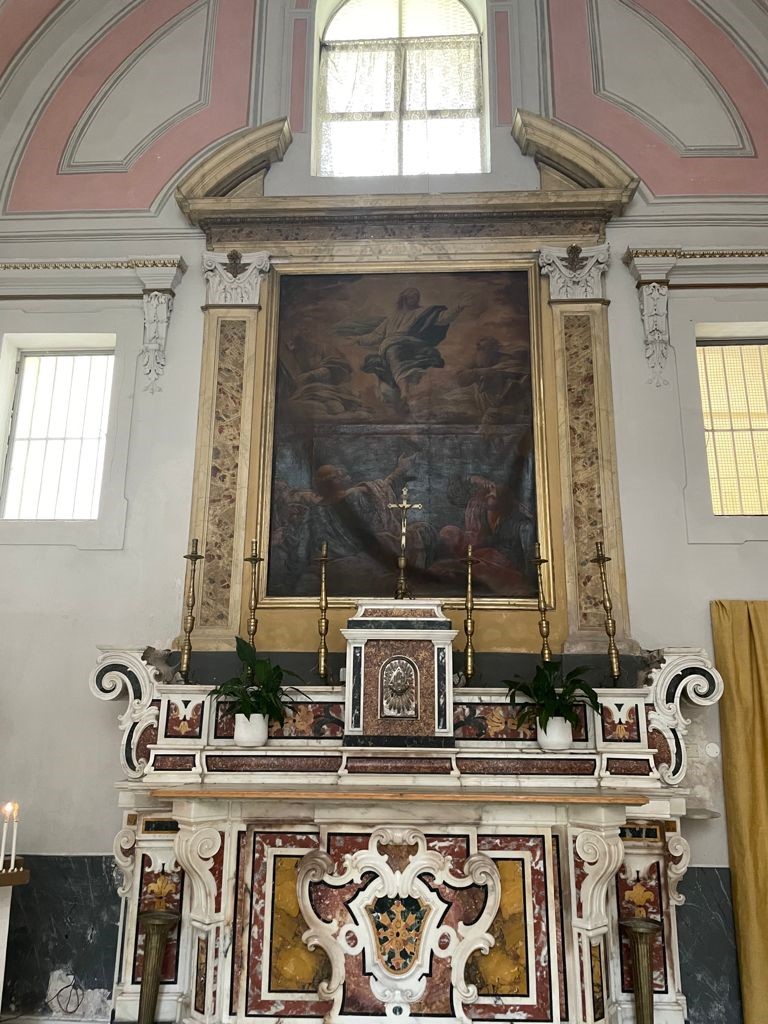
Detail of the Chapel of the Holy Savior
Chapel of the Most Holy Savior
The third chapel on the left has on the altar the canvas with the Transfiguration , Jesus transfigured, Moses with the tablets of the law, the prophet Elijah, below the apostles Peter, James and John appear.
A niche on the left wall preserves a wooden statue of S. Biagio , who wants to have healed a child wounded in the throat with a fishbone, in fact a child is depicted next to the saint.
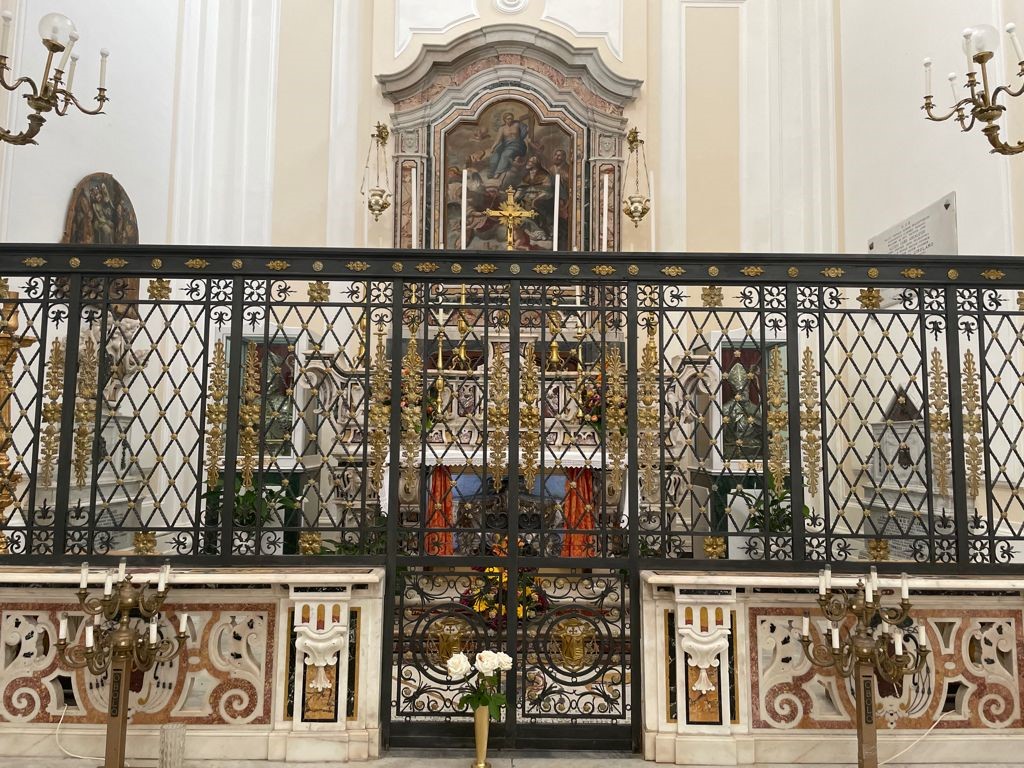
Chapel of S. Stefano and S. Ferdinando
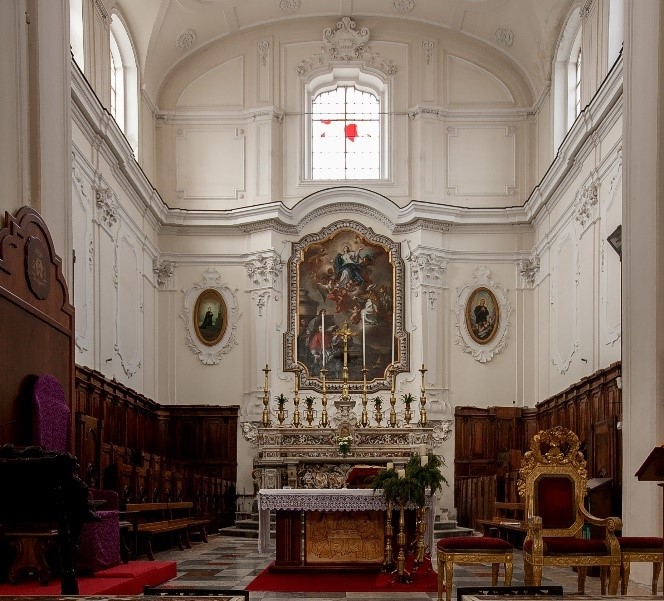
High Altar (Before renovation)
High Altar
The altarpiece with The Assumption of the Virgin painted in the mid-18th century is by the Apulian painter Leonardo Olivieri, depicting Mary in the center, in the glory of the heavens, on her right the Saints Stephen and Ferdinand, who they intercede for the people, a canon in a red tunic and the dome of the cathedral next to the bishop Vigilante who wanted its construction are depicted at the foot.
Above the painting we see the lamb of the Apocalypse and the book with the symbolic seven that keep the book closed.
The apse is and is rectangular with barrel vaults, there are three more large windows on each side with corresponding lunettes. On both sides of the marble altar there is the wooden choir, restored in 2015, with 11 stations. The bishop’s seat, on the other hand, is leaning against the left pillar of the arch of the apse.
While we find the wooden pulpit supported by the last right pillar of the central nave.
In the latest restoration and conservation work on the Co-Cathedral, a new marble altar was built in the center of the presbytery. To create the base of the altar, two altar heads present in the nearby Church of the Annunciation were joined. The two altar heads take up the shapes and materials of the main altar and the balustrade consisting of vaults in white marble with inlays of polychrome marbles (Verde Antico, Rosso Verona and Rosso Antico). The two cornerstones, mainly two shelves, were put together to then allow the support of the carrara marble top with bronze spacer elements.
The new altar was consecrated by Bishop Giacomo Cirulli on 29 October 2021 on the occasion of the celebration of the feast of the Patron Saint.
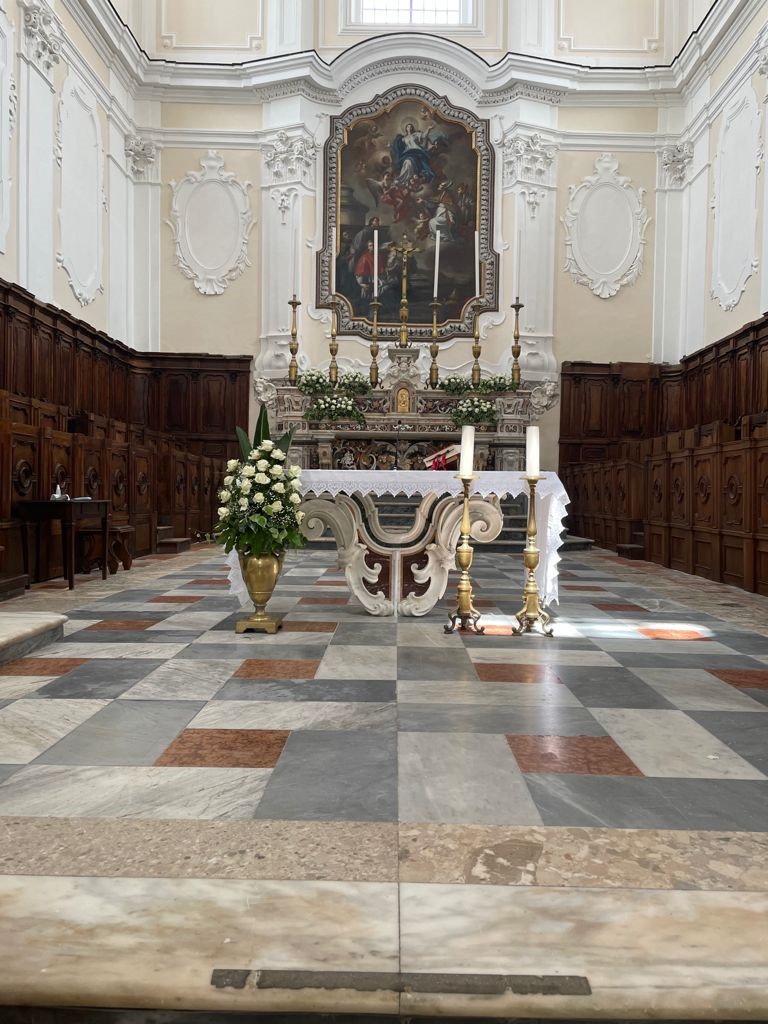
Current High Altar
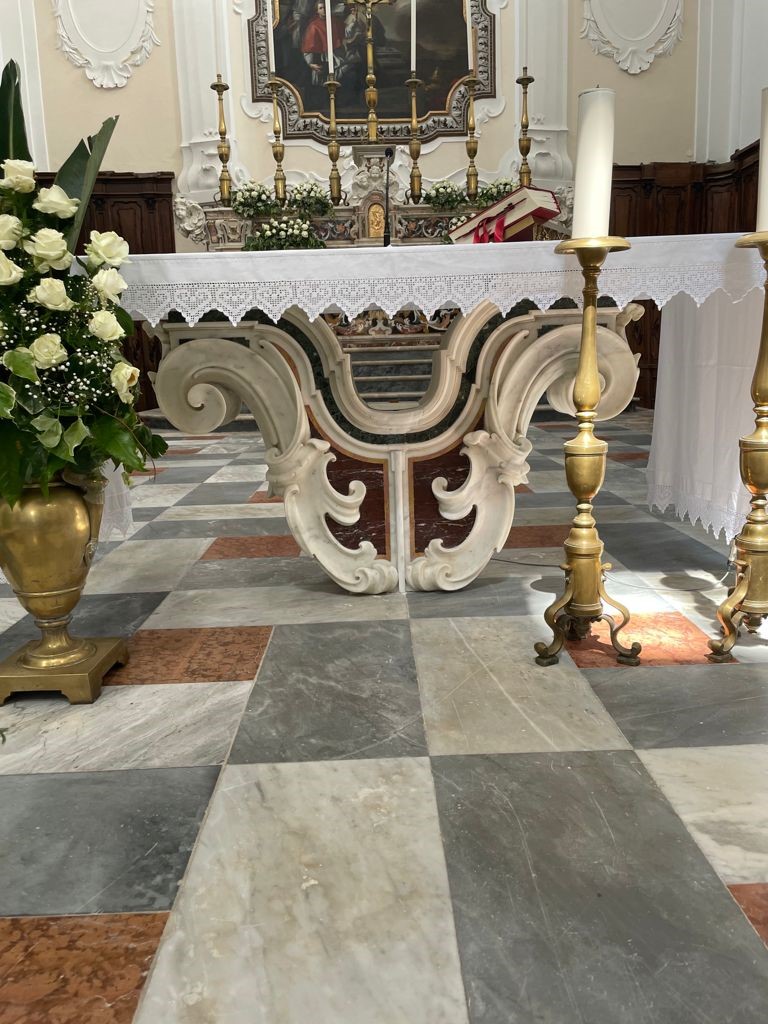
Detail of the New High Altar
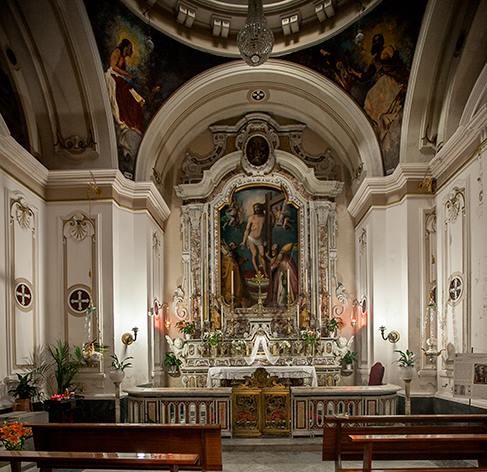
Chapel of the Blessed Sacrament
Chapel of the Blessed Sacrament ex novo
In 800 the Blessed Sacrament was dismantled from the current chapel of S. Maria dei Flagelli (first chapel on the left from the entrance).
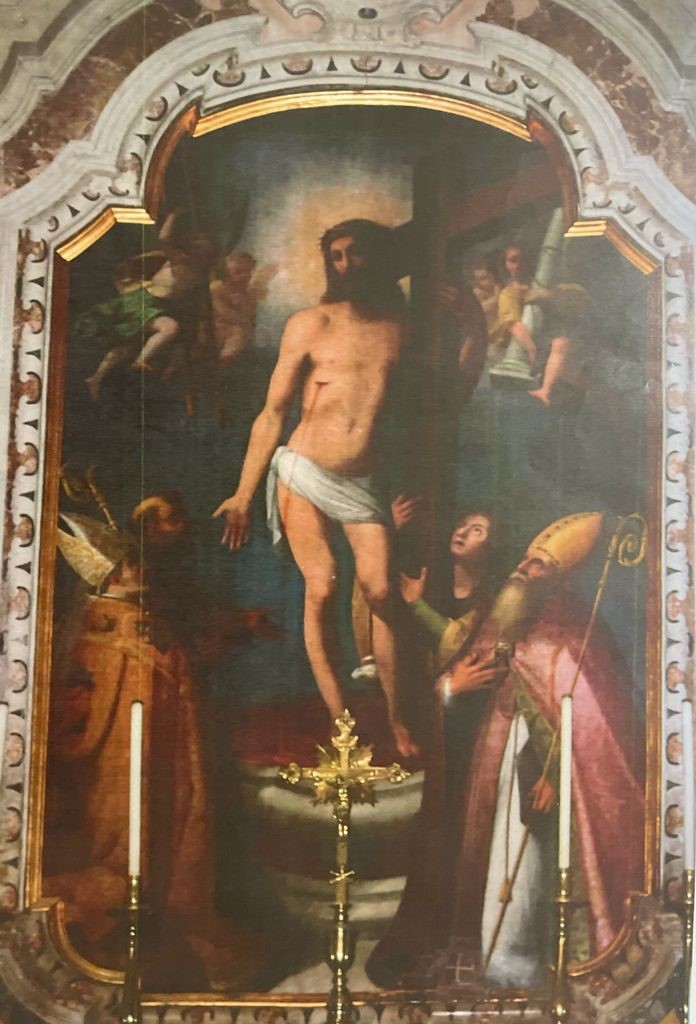
Resurrected Jesus painting
In the chapel we find Risen Jesus, probably the work of Luigi Rodriguez, in the center at the top we observe the triumphant Christ embracing the cross surrounded by the symbols of the Passion, the staircase with nails and the column of the flagellation, carried by the angels. The blood gushes at his feet filling a basin, from which 7 jets gush out to symbolize the seven sacraments.
Below we see S. Francesco, S. Maria Maddalena and the bishops S. Stefano and S. Ferdinando.
Above the picture two angels are depicted carrying the Eucharist.
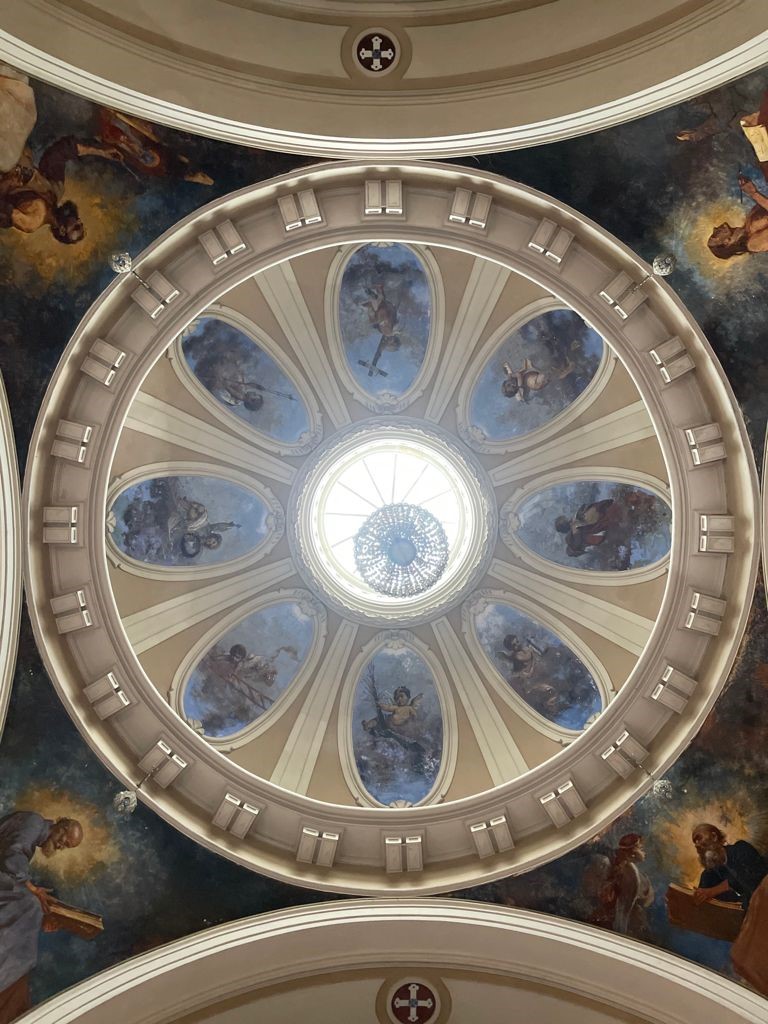
Dome of the Blessed Sacrament
Among the frescoes in the chapel with the 4 pendentives we find the four evangelists (Luca, Giovanni, Matteo and Marco).
At the segments of the dome we find instead depicted the Cherubs with the symbols of the passion.
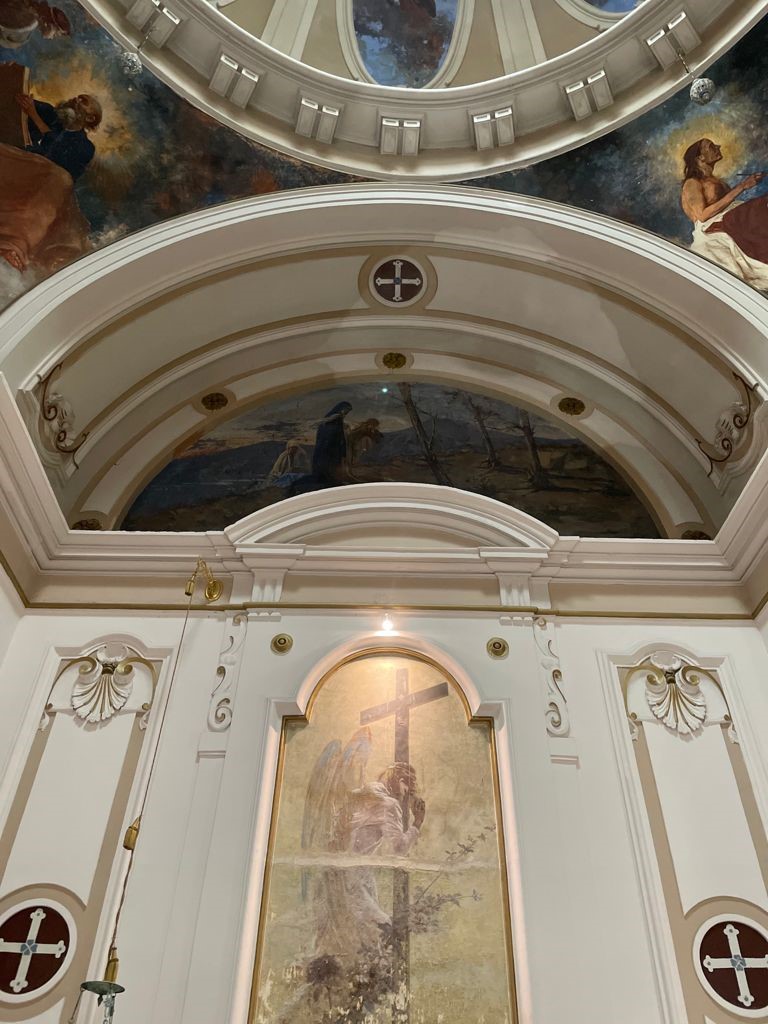
Fresco represents an Angel with the symbols of the passion
On the walls instead we have an Angel with the symbols of the passion (the cross) and on the other wall the Vessillo della Veronica. In the two lunettes, on the other hand, the Lamentation over the dead Christ and the Three Marys at the sepulcher are portrayed. The frescoes are attributed to Vincenzo Severino, a Caiatine painter who studied under the influence of Domenico Morelli at the Academy of Fine Arts in Naples.
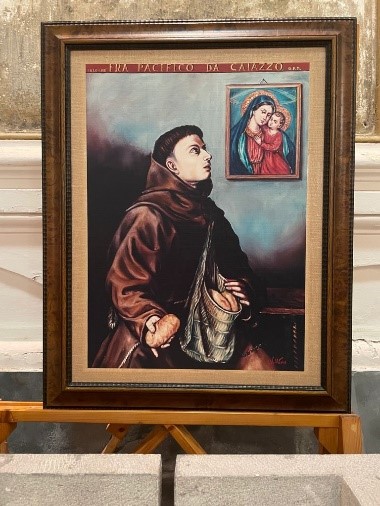
Fra Pacifico of Caiazzo
Fra Pacifico
Born in Caiazzo near SS. Giovanni e Paolo on December 29, 1853, undertook the path of the Poverello of Assisi on January 6, 1875, in June two years later he wore the clothes of the order with the name of Fra Pacifico da Caiazzo. In a short time his figure became very popular throughout the city of Naples, for his ability to listen and help.
On 29 December 1986 from the cemetery of Moiano (NA) the remains were transferred to the cathedral of Caiazzo, in the chapel of the SS. Sacramento, next to the tomb there is a reliquary where many ex voto offered as a gift to give thanks for a grace received are kept.
At the moment Fra Pacifico has not yet received the title of saint but slow thanks to the testimonies we are trying to carry out the process of beatification and canonization.
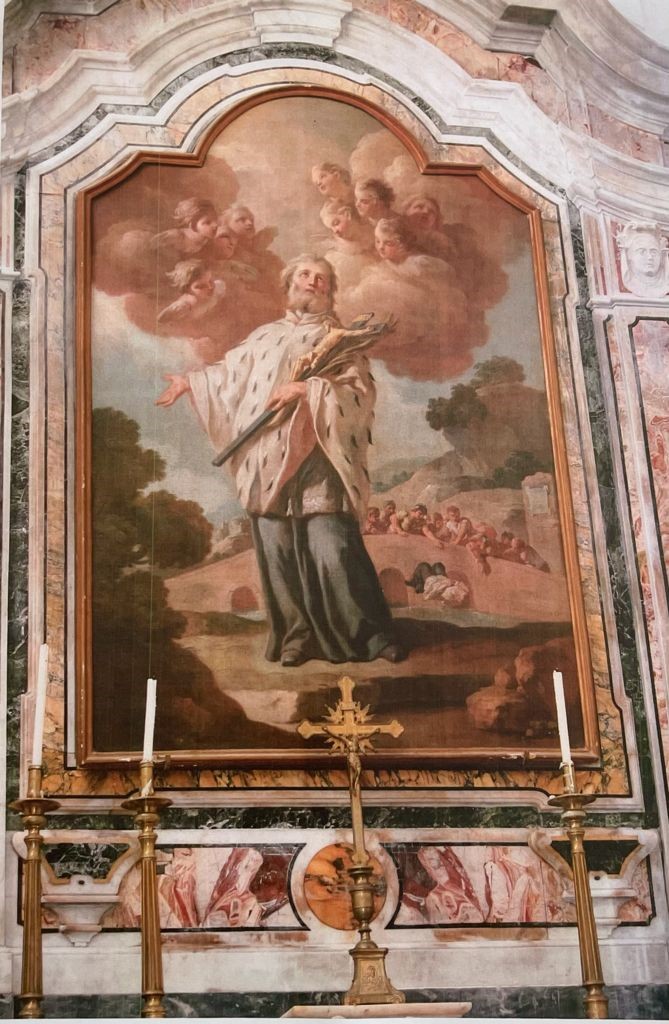
Altar of S. Giovanni Nepomuceno
Altar of S. Giovanni Nepomuceno
Right arm of the transept
Before entering the chapel of the Blessed Sacrament we find the painting of S. Giovanni Nepomuceno , the patron saint of those whom he is told ill about, as he was killed by the king of Sweden who, very jealous of his wife, wanted to force his confessor, Giovanni, to betray the confessional secret.
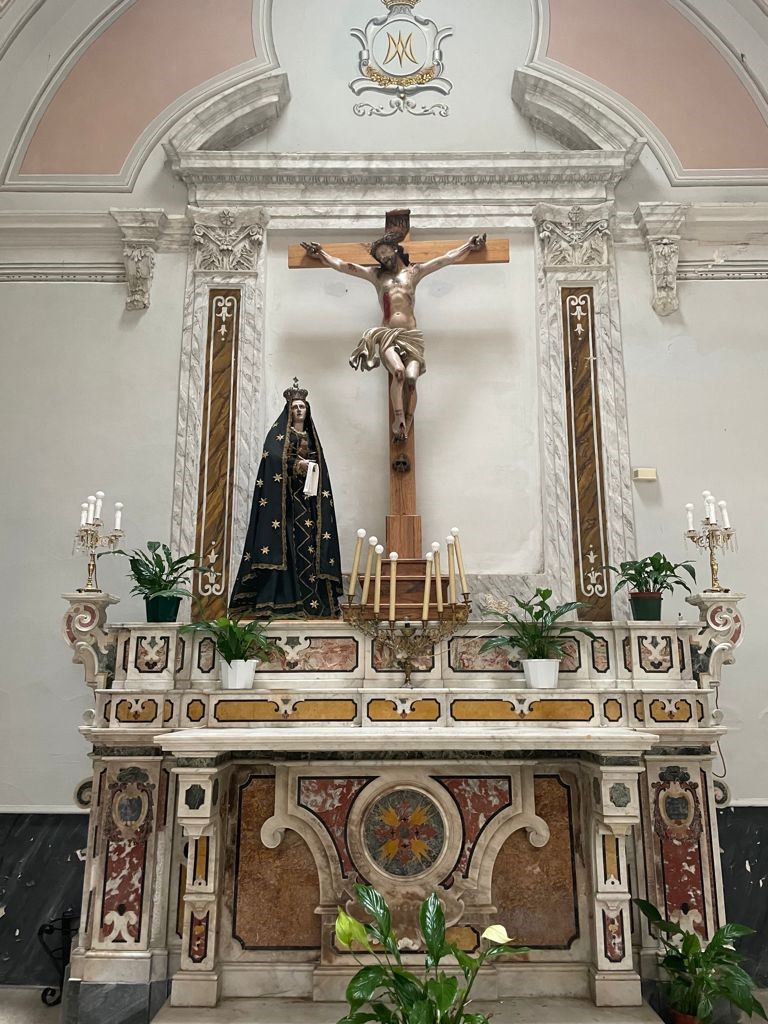
Chapel of the Addolorata
Made in the twentieth century with a statue of Santa Rita da Cascia, the iconography usually describes it with an observing crucifix. According to the devotional tradition, on the evening of Good Friday in 1432, when she retired in prayer, she received a thorn from the crown of the Crucifix stuck in her forehead (in fact, a sign on the temples is depicted in the iconography).
The decoration of the vault was done by the recently deceased artist from Caia, Domenico Tessitore, in memory of his parents..
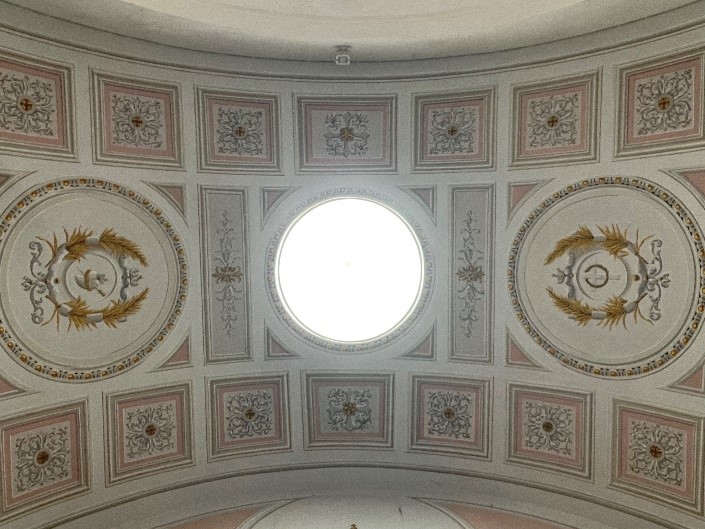
Dome Chapel of the Addolorata
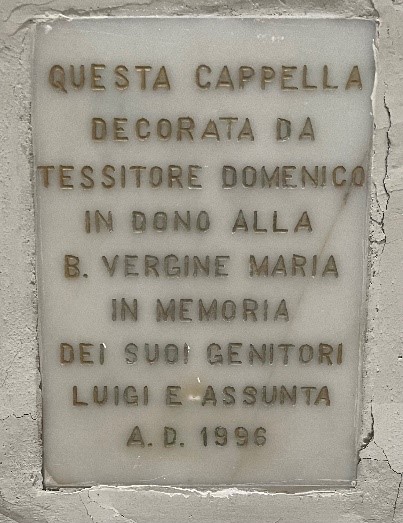
Donation of Domenico Tessitore
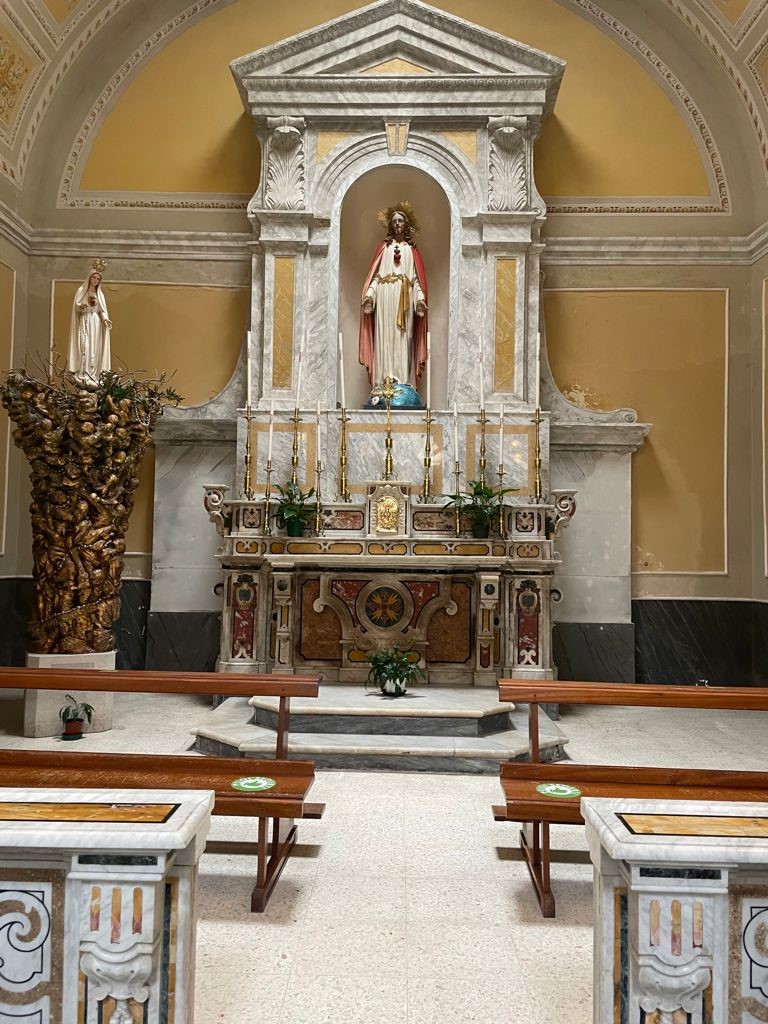
Chapel of the Sacred Heart of Jesus
Chapel of the Sacred Heart of Jesus
Made in the twentieth century, it preserves the statue of the heart of Jesus. Traditional iconography wants Jesus Christ to be with the heart in evidence with a cross on it, the heart is wounded to symbolize the wounds of sins worked by us men and is surrounded by flames, symbol of the mercy and love of the dead Savior for us.
The chapel also houses the master’s Tree of Life Luca Pannone.
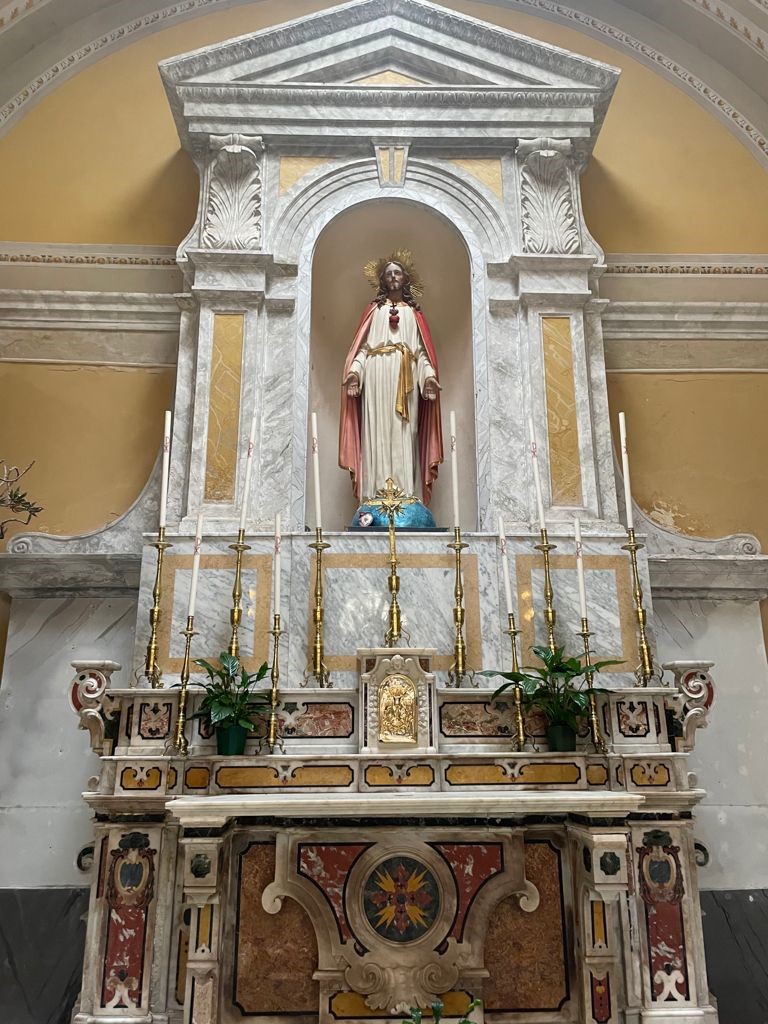
Detail of the chapel of the Sacred Heart of Jesus
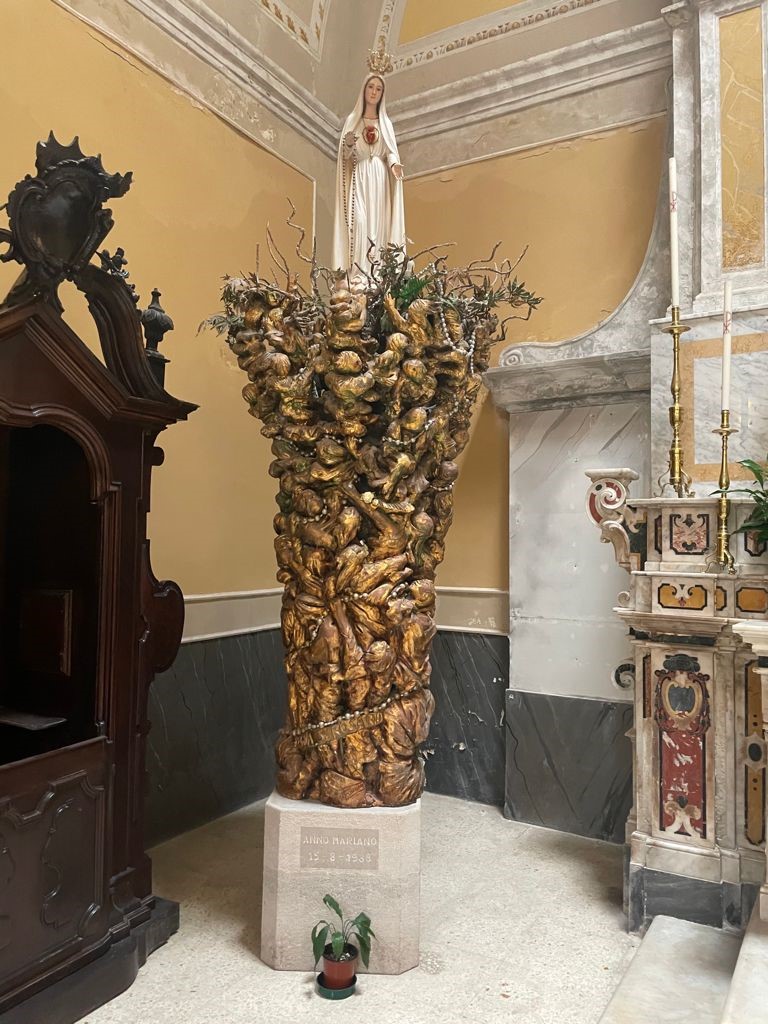
Detail of the chapel of the Sacred Heart of Jesus
Works preserved inside the Concattredale
Inside the structure some works are kept, such as:
– the Annunciation with a kitten by Francesco De Mura, an altarpiece of the Annunziata, in whose place there is now a copy (in front of the SS);
-Pietà among the SS. Stefano and Ferdinando painting attributed to Stefano Sparano (S. Stefano Chapel);
Sacristy:
– S. Francescoan oil on panel, in which the saint stands out against a blue background, this work too is usually attributed to Stefano Sparano;
– S. Lucia;
– Madonna of the milk 16th century.
